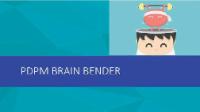Submitted by Mira Waszak, Therapy Resource, Pennant – WA
 Connecting and training with our teams has been challenging in our new normal. So how do we make training effective and fun on a Zoom call? Introducing PDPM Brain Benders by Jessika Booth, MDS Resource/Pennant WA. She created a simple but effective exercise bringing the 9 Washington IDTs together on a 30-minute Zoom call.
Connecting and training with our teams has been challenging in our new normal. So how do we make training effective and fun on a Zoom call? Introducing PDPM Brain Benders by Jessika Booth, MDS Resource/Pennant WA. She created a simple but effective exercise bringing the 9 Washington IDTs together on a 30-minute Zoom call.
Jessika forwarded Reference tools the day before the Zoom meeting, which included:
PDPM quick reference guide
PDPM ST comorbidity CMI guide
NTA workbook
PDPM ICD10 Mapping
PDPM Nursing quick reference guide
And a sample diagnosis list
Zoom call format
Brain Bender Rules:
• Mute your lines unless called on or when conversation is opened to the group
• First facility to type facility name in chat answers the question
• If wrong, the second facility with name in chat will get opportunity for half of the points with correct answer
• Next question picked by facility with correct answer
Teams were only given the diagnosis sheet to answer some of the sample questions below:
Question: What PT/OT Clinical Category does the current primary diagnosis of OSTEOMYELITIS Unspecified – M86.9 map to?
Answer: Other Orthopedic
Question: Based on the diagnosis list provided, are there currently any SLP CO-MORBIDITIES available?
Answer: No, none of the diagnoses listed will map to an SLP Co-morbidity 410.
Question: Based on Diagnosis review, what would the IDT need to clarify in order to get the resident into a Special Care High Category?
Answers:
● The type of Quadriplegia — as you can only code I5100 Quadriplegia if it is a result of spinal cord injury.
● Sepsis — related to osteomyelitis and or UTI
● Respiratory Therapy — Hypoventilation Syndrome
● COPD and other restrictive lung disease — Hypoventilation Syndrome
Special thanks to Jessika Booth and our MDS partners! Congratulations to team Park Manor for winning this round of PDPM Brain Benders.
